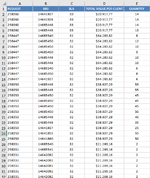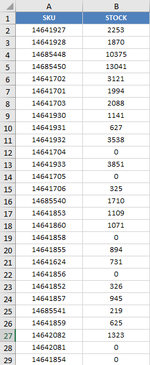SunProj3cT
New Member
- Joined
- Nov 2, 2021
- Messages
- 3
- Office Version
- 365
- Platform
- Windows
Hello, guys
I'm having a hard time finding a more intelligent (and less repeatable) way of solving a problem I have at work. I think that the only way of solving it is with VBA, but I'm totally open to suggestions
Basically, I have a database of stock by SKU and another database of requests by SKU, which also contains some informations such as: Quantity ordered, Total Value ($) per client (sum of all total value of all requests from the same client) and SLA.
The priority list of requests to be attended - if possible - is (1) from greater to lesser SLA and (2) from greater to lesser Total Value per Client.
What I need to do is to check if every SKU on the same request has an available stock equal or greater than the quantity ordered. If so, then I would need an info (such as a verification column with a number "1" on it) that this request will be attended and I would also need an updated stock with the consumed quantity. If at least one of the SKUs cannot be attended, then the entire request will not be attended, the stock will not update and the verification column would have its info as well (such as a number "0" on it).
Even though I think it doesn't seem to be a difficult problem to solve, I'm not finding a way to get rid of countless loops and ifs.
A loop to input the table into a matrix, a loop to verify if the request is still the same request, a loop to check the quantity with the available stock, a loop to update the stock, a loop to check if the full request can be attended, a loop to "re-update" the stock to the older one if the full request cannot be attended, and on and on and on...
Here are some screenshots of the database to help clarify the issue.
Thanks so much in advance!
I'm having a hard time finding a more intelligent (and less repeatable) way of solving a problem I have at work. I think that the only way of solving it is with VBA, but I'm totally open to suggestions
Basically, I have a database of stock by SKU and another database of requests by SKU, which also contains some informations such as: Quantity ordered, Total Value ($) per client (sum of all total value of all requests from the same client) and SLA.
The priority list of requests to be attended - if possible - is (1) from greater to lesser SLA and (2) from greater to lesser Total Value per Client.
What I need to do is to check if every SKU on the same request has an available stock equal or greater than the quantity ordered. If so, then I would need an info (such as a verification column with a number "1" on it) that this request will be attended and I would also need an updated stock with the consumed quantity. If at least one of the SKUs cannot be attended, then the entire request will not be attended, the stock will not update and the verification column would have its info as well (such as a number "0" on it).
Even though I think it doesn't seem to be a difficult problem to solve, I'm not finding a way to get rid of countless loops and ifs.
A loop to input the table into a matrix, a loop to verify if the request is still the same request, a loop to check the quantity with the available stock, a loop to update the stock, a loop to check if the full request can be attended, a loop to "re-update" the stock to the older one if the full request cannot be attended, and on and on and on...
Here are some screenshots of the database to help clarify the issue.
Thanks so much in advance!







